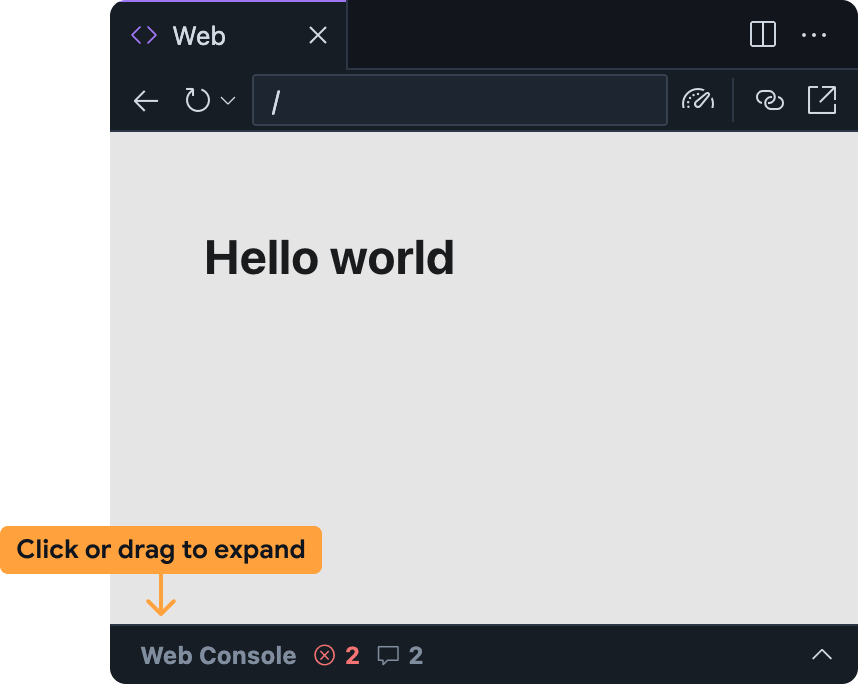Firebase Studio มีวิธีต่างๆ ในการแก้ไขข้อบกพร่องของแอปโดยตรงจากพื้นที่ทำงาน สำหรับเว็บและแอป Flutter เราได้ผสานรวมคอนโซลเว็บและ Lighthouse เข้ากับพื้นที่ทำงานโดยตรง แอป Flutter มีตัวอย่าง Android และเว็บ เพื่อให้คุณตรวจสอบและทดสอบแอปขณะเขียนโค้ด
นอกจากนี้ การแก้ไขข้อบกพร่องที่ละเอียดยิ่งขึ้นตามเบรกพอยต์ยังพร้อมให้บริการสำหรับภาษาที่ใช้กันโดยทั่วไปส่วนใหญ่ ผ่านคอนโซลการแก้ไขข้อบกพร่องในตัว และขยายได้ด้วยส่วนขยายดีบักเกอร์ จาก OpenVSX สำหรับการแก้ไขข้อบกพร่องที่อิงตามจุดพักของโค้ดเว็บส่วนหน้า (เช่น JavaScript) คุณสามารถใช้เครื่องมือสำหรับนักพัฒนาซอฟต์แวร์ในตัวของเบราว์เซอร์ต่อไปได้ เช่น DevTools ของ Chrome
แสดงตัวอย่างแอป
Firebase Studio ประกอบด้วย ตัวอย่างแอปในพื้นที่ทำงานสำหรับเว็บแอป (Chrome) และแอป Flutter (Android, Chrome) การแสดงตัวอย่าง Android และ Chrome รองรับการโหลดซ้ำและการรีเฟรชด่วน รวมถึงมี ความสามารถของโปรแกรมจำลองอย่างเต็มรูปแบบ
ดูข้อมูลเพิ่มเติมเกี่ยวกับFirebase Studioการแสดงตัวอย่างได้ที่ แสดงตัวอย่างแอป
ใช้เว็บคอนโซลแบบผสานรวมเพื่อดูตัวอย่างเว็บ

เว็บคอนโซลแบบผสานรวมช่วยให้คุณวินิจฉัยปัญหาในแอปได้โดยตรง จากตัวอย่างบนเว็บ คุณเข้าถึงคอนโซลเว็บได้ใน Firebase Studioแผงแสดงตัวอย่างเว็บโดยขยายแถบที่ด้านล่าง
โปรดทราบว่าฟีเจอร์นี้อยู่ในขั้นทดลองและไม่ได้เปิดใช้โดยค่าเริ่มต้น หากต้องการเปิดใช้ ให้ทำตามขั้นตอนต่อไปนี้ และแชร์ความคิดเห็นหลังจากที่ได้ลองใช้แล้ว
วิธีเพิ่มเว็บคอนโซลไปยังพื้นที่ทำงาน Firebase Studio
- เปิดการตั้งค่าโดยคลิก
หรือกด
Ctrl + ,(ใน Windows/Linux/ChromeOS) หรือCmd + ,(ใน MacOS) - ค้นหาการตั้งค่า Firebase Studio: เครื่องมือสำหรับนักพัฒนาซอฟต์แวร์บนเว็บ แล้วเปิดใช้
หากแก้ไขไฟล์
settings.jsonโดยตรง คุณจะเพิ่ม"IDX.webDevTools": trueได้ - รีเฟรชหน้าต่างเบราว์เซอร์เพื่อโหลดFirebase Studio พื้นที่ทำงานซ้ำ
- เปิดการตั้งค่าโดยคลิก
หรือกด
เปิดตัวอย่างเว็บใน Firebase Studio: เปิดจานสีคำสั่ง (
Cmd+Shift+Pใน Mac หรือCtrl+Shift+Pใน ChromeOS, Windows หรือ Linux) แล้วเลือก Firebase Studio: แสดงตัวอย่างเว็บระบบจะย่อแผงคอนโซลเว็บภายในแผงแสดงตัวอย่างเว็บโดยค่าเริ่มต้น คลิกแถบหรือลากขึ้นเพื่อขยาย
แผงคอนโซลเว็บในFirebase Studioตัวอย่างเว็บทํางาน คล้ายกับคอนโซลอื่นๆ เช่น คอนโซลที่มีอยู่ใน เครื่องมือสำหรับนักพัฒนาเว็บใน Chrome
- ข้อผิดพลาด JavaScript และคำสั่ง
console.logจะปรากฏที่นั่นขณะที่คุณใช้แอป- สำหรับข้อผิดพลาดและคำเตือน คุณยังมีตัวเลือกในการรับความช่วยเหลือจาก Gemini โดย เลือกปุ่มทำความเข้าใจข้อผิดพลาดนี้ทางด้านขวาของ ข้อความแสดงข้อผิดพลาด
- คุณประเมิน JavaScript ที่กำหนดเองในบริบทของตัวอย่างเว็บได้โดยใช้แถบพรอมต์ที่ด้านล่าง
เรียกใช้ Lighthouse สำหรับตัวอย่างเว็บ
Lighthouse จะตรวจสอบแอปของคุณตามหมวดหมู่การตรวจสอบที่เฉพาะเจาะจงที่คุณเลือก และแสดง รายงานพร้อมผลการตรวจสอบและคำแนะนำ คุณเรียกใช้รายงาน Lighthouse ได้โดยตรง จากตัวอย่างเว็บใน Firebase Studio
เปิดตัวอย่างเว็บใน Firebase Studio: เปิดจานสีคำสั่ง (
Cmd+Shift+Pใน Mac หรือCtrl+Shift+Pใน ChromeOS, Windows หรือ Linux) เลือก Firebase Studio: แสดงตัวอย่างเว็บคลิกไอคอน
เรียกใช้ Lighthouse จากแถบเครื่องมือตัวอย่างเว็บ
 ใน
แผง Lighthouse ให้เลือกหมวดหมู่การตรวจสอบที่ต้องการ คุณเลือกรายงานที่ตรวจสอบประสิทธิภาพ การช่วยเหลือพิเศษ
การปฏิบัติตามแนวทางปฏิบัติแนะนำ SEO และประสิทธิภาพของ Progressive Web App ได้ คลิกวิเคราะห์หน้าเว็บเพื่อสร้างรายงาน
ใน
แผง Lighthouse ให้เลือกหมวดหมู่การตรวจสอบที่ต้องการ คุณเลือกรายงานที่ตรวจสอบประสิทธิภาพ การช่วยเหลือพิเศษ
การปฏิบัติตามแนวทางปฏิบัติแนะนำ SEO และประสิทธิภาพของ Progressive Web App ได้ คลิกวิเคราะห์หน้าเว็บเพื่อสร้างรายงานรายงานอาจใช้เวลาสักครู่ในการสร้าง
หลังจากรายงานปรากฏในแผง Lighthouse คุณจะตรวจสอบผลการตรวจสอบสำหรับหมวดหมู่การตรวจสอบแต่ละหมวดหมู่ หรือสลับระหว่างหมวดหมู่การตรวจสอบได้โดยคลิกคะแนนและชื่อหมวดหมู่
ใช้คอนโซลแก้ไขข้อบกพร่อง
Firebase Studio มีคอนโซลดีบักในตัวจาก Code OSS ใช้คอนโซลนี้เพื่อแก้ไขข้อบกพร่องของแอปด้วยดีบักเกอร์สำเร็จรูปสำหรับภาษาโปรแกรมที่ใช้กันมากที่สุด หรือเพิ่มส่วนขยายการแก้ไขข้อบกพร่องจาก OpenVSX
หากต้องการปรับแต่งประสบการณ์การแก้ไขข้อบกพร่อง คุณยังเพิ่ม.vscode/launch.json
ไฟล์ลงในพื้นที่ทำงานและระบุการกำหนดค่าการเปิดใช้ที่กำหนดเองได้ด้วย ดูข้อมูลเพิ่มเติม
เกี่ยวกับการใช้ไฟล์การกำหนดค่าการเปิดใช้เพื่อปรับแต่งการแก้ไขข้อบกพร่องได้ที่
การกำหนดค่าการแก้ไขข้อบกพร่องของ Visual Studio Code
แก้ไขข้อบกพร่องด้วย Gemini
คุณใช้ Gemini ใน Firebase เพื่อช่วยดีบักโค้ดด้วย แชทในพื้นที่ทำงาน Code หรือ App Prototyping agent ได้
แม้ว่า Gemini จะเขียนโค้ดให้คุณได้ แต่บางครั้งก็อาจ สร้างข้อผิดพลาดได้เช่นกัน เมื่อตรวจพบข้อผิดพลาด ระบบจะพยายาม แก้ไข หากพบว่าเครื่องมือไม่สามารถแก้ปัญหาได้เมื่อได้รับข้อความแสดงข้อผิดพลาด ให้ลองใช้เทคนิคต่อไปนี้
อธิบายปัญหา: ในอินเทอร์เฟซแชท ให้อธิบายปัญหาที่คุณพบให้ชัดเจนและกระชับที่สุด แม้ว่า Gemini อาจมีสิทธิ์เข้าถึงบริบท เช่น ข้อความแสดงข้อผิดพลาด และบันทึก แต่ก็อาจไม่เข้าใจบริบททั้งหมด การอธิบายลักษณะการทำงานพร้อมกับข้อความแสดงข้อผิดพลาดจะช่วยให้ Gemini แก้ไขข้อผิดพลาด ได้เร็วขึ้น
ถามคำถามที่เจาะจง: ถามGemini คำถามเกี่ยวกับโค้ดของคุณได้เลย เช่น "อะไรอาจทำให้เกิด ข้อยกเว้น NullPointerException ในฟังก์ชันนี้" หรือ "ฉันจะป้องกัน สภาวะแข่งขันนี้ได้อย่างไร"
แบ่งปัญหาที่ซับซ้อนออกเป็นส่วนๆ: หากคุณกำลังเผชิญกับปัญหาที่ซับซ้อน ให้แบ่งปัญหาออกเป็นส่วนย่อยๆ เพื่อให้จัดการได้ง่ายขึ้น ขอให้ Gemini ช่วยคุณแก้ไขข้อบกพร่องของแต่ละส่วนแยกกันและคิด แก้ปัญหาทีละขั้นตอน
ใช้บล็อกโค้ด: เมื่อแชร์ข้อมูลโค้ด ให้ใช้บล็อกโค้ด เพื่อให้มั่นใจว่าโค้ดได้รับการจัดรูปแบบอย่างถูกต้อง ซึ่งจะช่วยให้ Gemini อ่านและทำความเข้าใจโค้ดได้ง่ายขึ้น
ทำซ้ำและปรับแต่ง: Gemini อาจไม่ได้ให้โซลูชันที่สมบูรณ์แบบเสมอไปในครั้งแรก ตรวจสอบคำตอบ ถามคำถามเพื่อขอข้อมูลเพิ่มเติม และให้ข้อมูลเพิ่มเติมตามที่จำเป็น
หลีกเลี่ยงการวนลูปของพรอมต์: หาก Gemini ติดอยู่ในลูปหรือ ตอบคำถามไม่ได้ ให้ลองเปลี่ยนคำพรอมต์หรือ ให้บริบทเพิ่มเติม บางครั้งเพียงแค่เปลี่ยนคำถามก็ช่วยให้ Gemini เข้าใจสิ่งที่คุณถามได้
หากการเรียบเรียงพรอมต์ใหม่ไม่ช่วยแก้ปัญหาการวนซ้ำ ให้ลองใช้เทคนิคต่อไปนี้
เริ่มแชทใหม่: หากคุณใช้ Gemini ในFirebase แชทในพื้นที่ทำงาน Code ให้เริ่มเซสชันแชทใหม่เพื่อรีเซ็ตบริบทของ Gemini ซึ่งจะช่วยให้คุณหลุดพ้นจากความเข้าใจผิดหรือสมมติฐานที่ Gemini อาจมีในการสนทนาก่อนหน้า
ยกตัวอย่างที่ขัดแย้ง: หาก Gemini กำลังตั้งสมมติฐานที่ไม่ถูกต้อง ให้ยกตัวอย่างที่ขัดแย้งเพื่อช่วยให้เข้าใจ ลักษณะการทำงานที่ถูกต้อง

